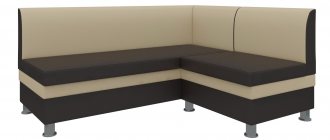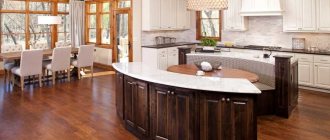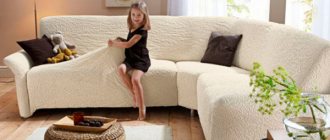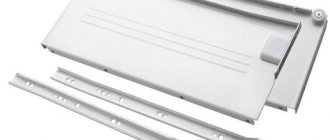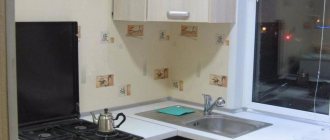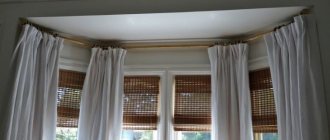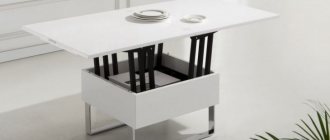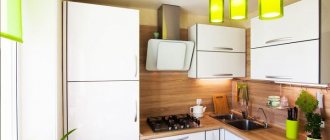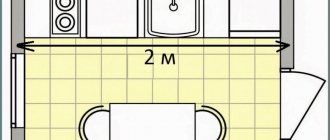From this material you will learn:
- Kitchen corner: sizes and standards
- What should be the dimensions of a small kitchen corner?
- Kitchen corner with sleeping area: dimensions and features of choice
- How to choose kitchen corner table sizes
- What else to pay attention to when choosing the size of the kitchen corner
- Kitchen corners: different sizes in the interior photo
Cabinets, a gas stove and work surfaces, of course, play key roles in the kitchen, but don’t forget about comfort - a kitchen corner, the size of which fits perfectly into your culinary kingdom, will become a real stronghold of comfort.
To correctly determine the dimensions, it is necessary to take into account many aspects and accepted standards. In this matter, a variety of factors play a role - material, style, location. Read on to find out how to choose the perfect model that will fit harmoniously in your kitchen.
Kitchen corner: sizes and standards
A classic kitchen corner consists of an L-shaped sofa and a dining table. The set can be supplemented with stools, soft ottomans or chairs.
Such designs allow you to use space economically, without affecting the practicality of the furniture or the appearance of the interior as a whole. There are 3 types of kitchen corners on sale:
- Left-handed - produced in the shape of the letter L.
- Right-handed - their shape is a mirror image of the letter G.
- Universal - consist of 2 sections, equal in length.
In furniture stores you can choose both sets with and without a table. Then, when purchasing, you will need to choose the missing element yourself, the appropriate size for the kitchen corner.
The most popular models are standard sizes, adapted for ordinary apartments. Among them there are 3 groups:
- minimal (length 150 cm, width 110 cm);
- maximum (200 × 140 cm);
- optimal (160 × 110 cm).
When paired with a rectangular sofa, the table does not extend beyond the boundaries of the furniture seats. In the case when the set is equipped with chairs, the area increases by approximately half a meter. In order for the furniture to fit the dimensions of the room, before purchasing it is better to draw up a drawing of the kitchen corner with dimensions and focus on the values indicated in it.
In the production of furniture, the recommended dimensional parameters are always taken into account, compliance with which helps to make it comfortable. Regarding the size of the kitchen corner, the standard states: the most comfortable seat depth for the average person should be 50–60 cm - this is enough to sit comfortably. Manufacturers offer options with a depth of 45–70 cm, which helps you choose a model suitable for a person of a certain build.
80–100 cm – this can be the height of the furniture. The value is determined by the size of not only the backrest, but also the seat. In the first case, the choice depends on personal preferences: some people like to lean completely on the back, while others prefer it to be no higher than the lower back. The height of the seats should be selected based on the average height of adult family members. It is correct if the legs bent at the knees form an angle of approximately 90°. In this case, the back and joints will be able to fully relax, which will have a positive effect on the condition of the body as a whole. Most often, the seat height is 40–50 cm.
The length of sections of L-shaped models is 110–140 cm (for the small part) and 150–200 cm (for the large part). This fork allows you to choose furniture that fits the size of your kitchen.
Manufacturing materials
A typical kitchen sofa consists of a base structure, filling and upholstery. The corners with solid wood bodies look the most respectable, but not everyone can afford such models. Furniture made from chipboard, MDF and fiberboard should be considered as budget options. It is important to remember that these materials tolerate high humidity less well. With constant contact with water, delamination of particle boards can be expected. To avoid such deformations, you should wisely choose the location of the corner.
In addition to wood options, some furniture manufacturers offer original and ultra-modern metal structures. Such products look harmonious in small kitchens decorated in modern and high-tech styles.
The choice of upholstery material is largely determined by the stylistic direction of the small kitchen. Models with natural and artificial leather coating are considered more practical. These materials are easy to clean and wash, and with proper care they can last for generations.
It is also worth purchasing furniture for the kitchen with upholstery made of synthetic fibers - they are more resistant to the penetration of unpleasant odors into the fabric structure. Manufacturers of high-quality kitchen furniture often use materials with water-repellent impregnation. This upholstery can be easily cleaned with a damp sponge.
Natural textile coverings in kitchen corners get dirty quickly and are difficult to clean.
In this situation, removable covers that can be easily machine washed come to the aid of the housewife.
The following materials are most often used as filler for kitchen corners:
- foam rubber is a standard option for such products;
- synthetic winterizer - used a little less often. Such corners are affordable, but the seats quickly lose their elasticity;
- polyurethane foam - the material is used to make premium furniture. Such products are wear-resistant. The service life of polyurethane foam corners is 10-20 times longer than the service life of cheaper fillers.
What should be the dimensions of a small kitchen corner?
In a small room, it is better to install a non-standard size model. A sofa that can accommodate a family of several people must be no less than 100 x 100 cm in size, otherwise its functionality will be reduced to zero.
The dimensions 110 x 110 cm are more convenient to use. Smaller furniture is no longer intended for a full-fledged family dinner time, but for a quick breakfast for 1-2 people.
In a small kitchen space you need to properly place a small set. The best place for it is the far wall, where it will not block the passage and interfere with the use of the work area. In a tight space, you can easily get injured by touching various elements of furniture, so it is better to purchase tables, chairs and sofas with rounded surfaces.
In a small kitchen, it is optimal to place a small straight model. There may be no backrest; instead, it is enough to fix a soft panel on the wall. Such furniture will perform its functions, and will take up much less space than standard furniture.
Kitchen corner with sleeping area: dimensions and features of choice
The dimensions of kitchen corners for small kitchens do not also include a sleeping area. This option will require a larger design, but it will also be more functional.
When choosing furniture, you must take into account the size of the kitchen corner when unfolded.
The minimum values should be as follows:
- for single models - 180 × 60 cm;
- for double beds – 180 × 120 cm.
You can purchase furniture with a smaller width only to order. For a design with a sleeping place, it is better to buy a transforming table and folding chairs. Regular models will not work, as they simply will not fit in the kitchen when the sofa is folded out.
The old fashioned way
A kitchen corner made of wood looks chic in any setting, whether it is made from solid wood or boards from unusable construction pallets - pallets, see fig. And making a wooden kitchen corner with your own hands may not be more difficult or more expensive than the one described above.
Kitchen corners made of wood
To start carpentry on wood, and not on viscous and fragile chipboard, it is not necessary to immediately buy an expensive triad of a jointing machine - a manual milling machine - a sander. You can get by with traditional hand (and non-volatile!) hand tools. Processing small parts in piece production with it often turns out to be easier and faster than readjusting the machine for the next operation.
To begin with, in addition to a jigsaw (we are not pedants, this tool is not very expensive, is often needed and is better than a bow saw in all respects), you will need a regular carpenter's plane, a hand jointer and a set of wood rasps. At first, one so-called will be enough. cabinet rasp, flat-convex with a tapered end, on the right in the figure:
Woodworking tools
You will also need selected (emphasis on the “s”) straight and beveled chisel planes (on the left in the figure). Using a straight chisel, remove the folds and select grooves along the fibers, and with an oblique blade across and plan the ends.
For primary processing of knotty wood, you need a sherhebel plane in the center. The sherhebel is used with a slight sliding to the side, as if cutting off and trimming knots. You can turn an ordinary plane into a sherhebel by placing a “piece of iron” knife with a rounded blade in it.
Having gained a little skill, it will be possible to replenish the tool park with another 3-4 types of selected planes with replaceable pieces of iron for them, see next. rice. Take a closer look at antique furniture: it was made with just such a tool, and not with modern machines with shaped cutters.
Selected planers for figure planing
The last point is the assembly (pulling together) of furniture panels from boards, they are also an array of furniture. In theory, this requires special devices - clamps - 3 per tabletop, 4 per cabinet sides and 2 per smaller panels. Here, firstly, one clamp can be replaced with a pair of jaws with clips for mounting on a rod, and a piece of timber of suitable thickness for the clips will go onto the rod, see figure; usually 60 mm. Sets of jaws for clamps and long clamps are sold separately.
Tension clamp made from a pair of jaws with clips and a piece of timber
Finally, wide panels are not needed for the kitchen corner; Most often, a shield for 3-4 boards is required. In this case, a shield from boards can be assembled without any special equipment at all, see video:
How to choose kitchen corner table sizes
The table should be combined with the rest of the elements of the set. Its main characteristics are strength and stability. Most often it is made from the same materials as the sofa.
These include MDF, chipboard, natural wood, metal. Due to their low cost, the first two options are most in demand, but the others have a longer service life. In addition, metal is generally not susceptible to damage, and wooden furniture can be restored if necessary.
What else to pay attention to when choosing the size of the kitchen corner
What criteria are best to adhere to when choosing?
First of all, the following information should be known:
- Kitchen area.
If the footage is small, only compact sets are considered (the dimensions of the kitchen corners with photos can be viewed in advance on the store’s website). - Number of family members.
It is necessary to choose the right table. A table for 6 people is considered a universal option. - Finishing method.
When researching this parameter, personal preferences, fashion trends and the style of the room as a whole are taken into account.
Kitchen corners of large and small sizes can be divided into two subgroups:
- Stationary corners
. These are one-piece structures, where two parts are connected to each other by fastening under the seat and on the back side, and one of the parts is longer than the other (the so-called L-shaped model). There was a time when all models were produced in one piece, non-separable, which caused a lot of inconvenience in operation. After all, the layout of the room may require the use of different types of corner sofas - both right-handed and left-handed. Therefore, over time, manufacturers began to produce similar furniture in different designs, which brought additional convenience to the consumer. - Modular models.
They are becoming more and more popular. This is facilitated by the mobility of structures consisting of several parts that can be removed altogether or swapped. This option is very convenient when there is a need to convert furniture from left-handed to right-handed, or vice versa.
If necessary, each module can be used separately, because all the elements are not fastened together, but only shifted. This option also has disadvantages. Considering that the pieces of furniture stand close to each other and are not fixed to either the floor or the walls, displacement occurs over time, and gaps form between the joints. Therefore, the elements will have to be shifted periodically, returning them to their original position.
The cost of stationary models is lower than that of modular ones. Therefore, if the location and shape of the corner are already indicated, it is better to purchase them. It is better to spend the difference on purchasing more expensive and high-quality upholstery material.
- L-shaped corner.
The best option in conditions of limited space. It is installed close to the wall to free up as much space as possible for the table. In such models, the back is usually small in thickness, but quite high and comfortable. One of the seats is often longer than the other, but the manufacturer can shorten it if necessary. - U-shaped model.
It looks very impressive, but only in a spacious room. Considering the footage of most typical apartments, the size of the soft kitchen corner will allow the installation of such a structure only in case of redevelopment. Of course, if the apartment is one of the exceptions, such a model can and should be purchased. Volumetric, overall, it will take up a lot of space, but it will also help to accommodate a large number of guests. Rectangular tables made of wood or glass go well with this option.
Individual order
If the kitchen has non-standard parameters, then it is worth making a kitchen corner according to individual dimensions. If the size of the kitchen allows, you should prefer U-shaped, semicircular or combined models. Although such models take up a lot of space, they always give the kitchen a special coziness and comfort.
